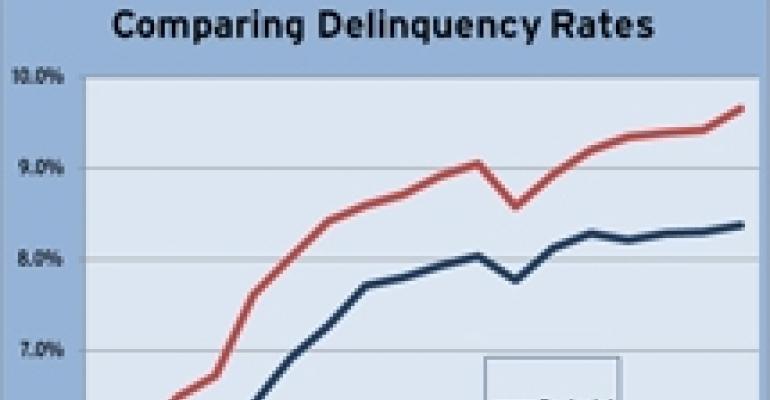CMBS delinquency rates continued their seemingly inexorable rise in April, according to the firms that track the sector.
As of the end of April, the CMBS delinquency rate stood at 8.37 percent according to Horsham, Pa.-based Realpoint LLC and at 9.65 percent according to New York City-based Trepp LLC. According to Trepp, it was the largest monthly jump in the CMBS delinquency rate since December with the rate rising 23 basis points. According to Realpoint, however, the jump was slighter—rising just 8 basis points month-over-month.

According to Realpoint, the delinquent unpaid balance for CMBS rose $371.9 million, up to $63.34 billion from $62.97 billion a month prior. This followed the previous month’s increase of $546.4 million. “Despite the one-month delinquency declines previously experienced in October 2010 and January 2011, both the delinquent unpaid balance and delinquency percentage over the trailing twelve months has continued to trend upward, but at a moderated pace compared to earlier in 2010 and 2009,” the firm wrote in its monthly report.
There was a net decline in both the 30-day and 60-day delinquency categories, according to Reapoint and net increases in the 90+day, foreclosure and REO categories.
The total unpaid balance for CMBS pools reviewed by Realpoint for the April remittance was $756.63 billion, down from $759.31 billion in March.
Inside the numbers
The delinquency ratio for February of 8.37 percent (up from the 8.29 percent reported for March) is 1.2 times the 6.91 percent reported in April 2010 and more than 29 times the Realpoint recorded low point of 0.28 percent in June 2007.

According to Realpoint, “The movement in both delinquent unpaid balance and percentage is now clearly being impacted by the size and amount of loan liquidations, modifications, extensions and resolutions reported on a monthly basis, leading to a potential slow-down in the reporting of new delinquency for the remainder of 2011.”
The firm projects that the delinquent unpaid balance for CMBS still has the potential to grow higher than 9 percent in 2011.
The delinquent unpaid balance in April 2011 increased despite $867.4 million in loan workouts and liquidations across 93 loans, at an overall average loss severity of 48.1 percent, according to Realpoint. This followed a one-month reporting high of $1.49 billion in loan workouts and liquidations across 148 loans in March 2011, at an overall average loss severity of 42.7 percent, according to the firm.
By property type, in April, multifamily loans topped retail loans as the greatest contributor to overall CMBS delinquency. Retail loans had been the greatest contributor for six straight months prior to June 2010. Delinquent multifamily loans account for 2.17 percent of the CMBS universe and 26 percent of total delinquency. The retail default rate increased slightly to 7.7 percent in April 2011 from 7.3 percent in March 2011. The current default rate compares to only 6.2 percent in April 2010.
Hotels, meanwhile, had the highest delinquency rate—13.2 percent, although the figure is down from a high of 14.3 percent in October 2010. The industrial delinquency rate rose to 10.0 percent in April—up from 9.5 percent in March and is at its high point. The multifamily delinquency rate rose to 9.5 percent, but is down from a peak of 10.2 percent in January. The office delinquency rate is at 6.8 percent and has fluctuated between 6.2 percent and 6.9 percent every month dating back to July 2010.
In its monthly report, Realpoint wrote, “Despite a leveling off over the past five months, we still consider retail delinquency a legitimate concern for 2011. A prolonged economic recovery could have further impact on consumer spending and cause retailers to continue to struggle. We also cannot rule out additional store consolidation, closings and potential bankruptcies along with growing balloon maturity default risk as retail collateral continues to suffer from the experienced decline”
Trepp's view
Meanwhile, in its analysis, New York City-based Trepp said that the CMBS delinquency rate rose to 9.65 percent in April, topping the previous high of 9.42 percent in March.

According to Trepp, “After three consecutive months in which the U.S. CMBS delinquency rate showed signs of leveling off, the rate re-accelerated in April. In February and March, the CMBS delinquency rate posted its smallest rates of increase since mid 2009. Those statistics, along with the view that CMBS lending was beginning to pick up steam, led many to believe that the worst was behind the CMBS market.”
The delinquency rate one year ago was 8.02 percent.
The jump came in spite of two factors Trepp identified as putting downward pressure on the delinquency rate. Firstly, new CMBS issues are being added to the data set, which increases the overall pool. Trepp adds issues after they have been seasoned for six months. Since newer issues are generally current, they tend to push the overall delinquency rate lower.
Secondly, “special servicers have been resolving a greater number of troubled legacy CMBS loans than they were 18 months ago. Accordingly, as troubled CMBS loans leave the universe - as they are sold off or modified - the balance of troubled CMBS loans is reduced. This, too, puts downward pressure on the delinquency rate,” Trepp wrote.
Multifamily remained the sector with the highest delinquency rate, according to Trepp. The multifamily rate is at 16.77 percent (up from 16.21 percent in March) while the lodging delinquency rate fell to 15.45 percent from 15.97 percent in March. The lodging delinquency rate peaked at 19.33 percent in September and been improving in recent months.
The delinquency rate for industrial properties rose to 10.76 percent from 10.25 percent in March. It has nearly doubled from a year ago when the rate stood at 5.41 percent. The delinquency rate rose for retail properties from 7.72 percent to 8.12 percent. It is the first time Trepp has measured the retail delinquency rate above 8 percent. The delinquency rate also rose for office properties from 7.13 percent to 7.20 percent.

